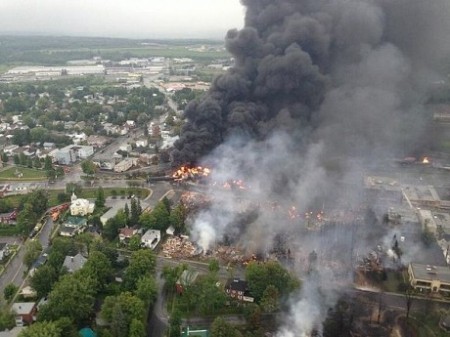Dangerous tank cars will be taken off the rails by Canadian government

Lac-Megantic burning on the first day after the rail car derailment sent fireballs and streams of burning oil coursing through the Quebec village. Photo: Surete du Quebec
The Canadian Press (via Huffington Post) is reporting today that the federal government of that county is ordering the 5,000 most dangerous tank cars off the rails. This, as the government adopts the Transportation Safety Board’s major recommendations in the wake of last year’s tragedy in Lac-Megantic. NCPR has reported extensively on that tragedy and the questions it raised about the dangers of transporting crude oil in tank cars deemed “unsafe” and “inadequate” (more, and here’s a recent piece on the issue.)
Here’s more from the Canadian Press:
Transport Minister Lisa Raitt says the immediate measures will take care of the most vulnerable of the older model tank cars, known as DOT-111, while those carrying crude oil and ethanol must be phased out or retrofitted within three years.
“We are immediately removing the least crash-resistant DOT-111 tank cars from dangerous goods service by directing the phase-out of tank cars that have no continuous reinforcement of their bottom shell in 30 days,” Raitt said.
Rail carriers will also be required to prepare emergency response assistance plans for shipments of all petroleum products, including everything for crude oil to diesel.
Emergency response is to be improved across the country through a task force involving municipalities, first responders, railways and shippers.
“We are always committed to improving railway safety and the transportation of dangerous goods by rail,” Raitt told a news conference.
She said there will be changes to insurance rules so that in the event of an accident there will be enough money available to cover compensation and cleanup costs.
“I also feel strongly that Canadians should not be expected to cover the costs of damages in the event of an accident.”
The actions are the latest response to last summer’s horrific derailment and fire in Lac Megantic that claimed 47 lives.
Concerns about the safety of DOT-111 tank cars date back at least 20 years.
The DOT-111 tank car is considered the workhorse of the North American fleet and makes up about 70 per cent of all tankers on the rails.
Tags: Lac-Mégantic, oil, rail safety, transportation








Here in Potsdam, an important part of the disaster preparedness plan should include connecting the Riverside drive neighborhood to the Sissonville road. This proposal was planned more than twenty years ago, but never carried out. In the event of a derailment, an entire neighborhood becomes trapped, and would have to swim across the river to escape.